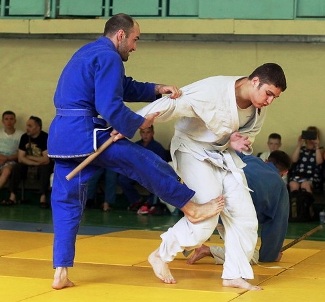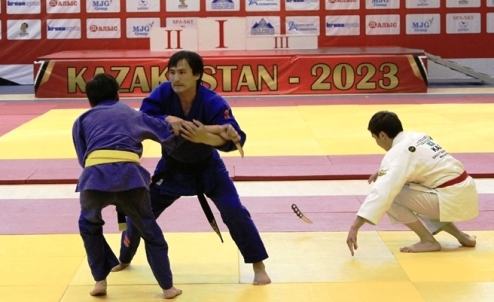THE RULES OF REFEREEING IN THE SELF-DEFENSE SECTION
9.1. Systems and methods of conducting competitions When transferring the competition, the participants appear in the same general group. In the "self-defense" section, weight categories are not provided. The order of the participants 'performances is determined by drawing lots and the selected system and method of conducting competitions. Only a thletes who have passed technical certification for belts in the relevant National Combat Ju-J u tsu Federation are allowed to compete: Х World Championship: - Athlete performing - not lower than 2nd kyu (blue belt), assistants - not lower than 3rd kyu (green belt); Х Continental Championship: - Athlete performing - not lower than 3rd kyu (green belt), assistants - not lower than 4th kyu (orange belt); Х National Championship: - Athlete performing - not lower than 4th kyu (orange belt), assistants - not lower than 5th kyu (yellow belt). Appropriate certificates are provided by the teams upon registration of participants. 9.2. Composition of the panel of judges The speeches of the participants are judged by a panel of judges consisting of: the head of the court, the referee, 2 side judges, a timekeeper, a technical secretary and an informant, and a trio of judges evaluating the actions of the participants. The team of judges evaluates the actions of the participants and the scoring in the speech. The three should be neutral and represent different teams. Each of them makes a decision on evaluating the actions of participants independently and, when analyzing protests and disputed issues, is obliged to justify their actions with the relevant provisions of the Rules. The referee, being on the court, directs the progress of the performance, controls the pace of attacks and the actions of assistants, gives instructions to the assistants to attack and change the nature of the attacks, makes sure that the fight takes place in strict accordance with the Rules. • Competitors and assistants in the Self-defense A competitor - a competitor conducts performance, reflects attacks and demonstrates the technique of action is evaluated judge; Assistants - perform different actions in attacking the referee teams, consisting of four people from different teams. 9.4. The content of speeches In a combat ju-jutsu battalion, assistants are allowed to carry out attacks with imitators of a knife, stick, hobbies and throws, punches and kicks. The athlete that performs must neutralize the attacks of the opponents by any of the following permitted actions: push, wedging, strike, throw, painful technique - and must meet the time allotted for the next attack 2.5-3 seconds. 9.4.1. Position of the participants: The athlete becomes in the middle of the tatami with a size of 6x6 m. Four assistants become in the corners of the tatami and, at the signal of the referee, alternately attack the athlete in 2.5-3 seconds. (The same for all participants). Two more assistants are next to the tatami, preparing to replace an assistant who has been injured or who is unscrupulously performing his duties. 9.4.2. Attacks: T ypes of attacks are used for 1 minute or 45 seconds for each type: • Attack with a knife simulator; • Stick attack; • Attack by blows of hands and feet; • Attack captures. Each attack should be neutralized. The concept of neutralizing an attack includes: leaving the line of attack (the attack should not fall into the athlete); the striker is unbalanced by jerking, pushing, throwing or striking; weapon selection during an attack with a knife and a stick or counterattack with blows, throws, painful techniques during an attack with blows and grabs. It is allowed a single escape from the attack without neutralizing it. Repeated care is punishable by penalty points. 9.5. The beginning and end of the speech 1. Before the show, the assistants, after their call up in the corners of the platform, the athlete who plays in the center of the site; 2. When entering the site and leaving the site, participants must complete the bow; 3. Before beginning performances at the referee's command took their places in the center and at the corners of the platform and on the command "Fight" ( "ray") performs a bow to referee and then to each other; 4.The performance ends at the referee's command. 9.6. The course and duration of the performance Time each attack takes 45-60 seconds. or 15-20 attacks each with a quantum of 2.5-3 seconds. (Only 60-80 attacks in 4 minutes Net time). The attack is carried out in one tempo, with one attack move without the use of technology transfer at work with weapons and change capture. The performance starts at the referee's command. Assistants follow the gestures of the referee and attack only at his command every 2.5-3 seconds. The referee is considered a gesture of the assistant, which should make the next attack. Assistants attack in a random order. The attack should be realistic and should be aimed at the athlete or pass through the place where he was supposed to be. Assistants, who in good faith perform their roles should be replaced when changing the type of attack. Only two such possible replacements. The assistant has the right to limit the attack power in the end phase, if he sees that the athlete he saw the attack heading into the vital organs, in order to avoid damage to the athlete. In this case, the attack must reach the goal, but with the restriction efforts. If the athlete is not able to free himself from capture, command "Stop", the attack is terminated and is resumed after a referee. • The result and performance evaluation First of all, the practicality of the technique is evaluated by the athlete. The judges evaluate the actions of the athlete by the presence of penalty points by subtracting the penalty points from 100 points that each athlete has at the beginning of the performance. Each of the three judges calculates the penalty points separately. After the performance, the three judges submit their results to the head judge, who concludes the athlete's points from each judge remaining after deduction of penalty points, determines the overall result of each athlete. Penalty points are awarded for: Х Double passive care from attacks - 2 points; Х Loss of balance and rhythm - 1 point; Х Not leaving the line of attack - 1 point; Х Do not unbalance the assistant attacker - 1 point; Х Lack of selection of weapons or counterattacks - 1 point; Х If a participant misses a knife blow into the body, head or neck cut - 25 points; Х If a participant misses a knife blow in an extremity or a cut of the body and limbs - 15 points; Х If a participant misses a stick in the head - 10 points; Х Unrealistic attack by the assistant, stopping the pace of the attack in the middle of the attack, feigning an attack or grab, playing along with the athlete - 10 points; Х If a participant misses a stick strike into the body or limbs - 5 points; Х If a participant misses a blow with his hands or feet - 5 points; Х Untimely release from capture - 5 points; Х Departure from the working zone - 5 points; If the number of penalty points exceeds 100 points, the athlete will be disqualified. 9.7.1. Prohibited Tricks and Actions In competitions in the Self-Defense section, in addition to the main provisions, it is prohibited: to use a counter strike without leaving the line of attack; strike in Full-Combat, perform throws and painful moves with damage to assistants; the assistant must not imitate the actions of the move or throw; the attack should not continue after the Stop command. Assistants constantly use the serial technique or the technique of transferring the emphasis of the attack and regularly carry out attacks too hard to be replaced with the next change in the nature of the attacks. • Announcement of the result of the performance Announcement of the result of the performance occurs after the performances of all participants, the calculation of the penalty points of each participant and the distribution of participants in places by each of the 3 judges. The position of the participants in the final table is determined by the sum of the places of this participant for each judge. 9.9. Conducting fights and refereeing for different age categories of participants. 1. Cadets 14-15 years old: For this age category, the following features apply: The rhythm of attacks is 3.5-4 seconds, No more than 12 attacks in each type of attack and no more than 30-40 seconds for each type of attack. Equipment of participants: A helmet with front protection, soft protection of the lower leg, protection of the groin, mouth guard, for assistants soft protection of the body is allowed. 2. Juniors 16-17 years old and veterans over 36 years old: For this age category, the following features apply: The rhythm of attacks is 3.5 seconds, No more than 15 attacks in each type of attack and no more than 45 seconds for each type of attack. Equipment of participants: A helmet with an open front, soft protection of the lower leg, protection of the groin, mouth guard, for assistants soft protection of the body is allowed. |




